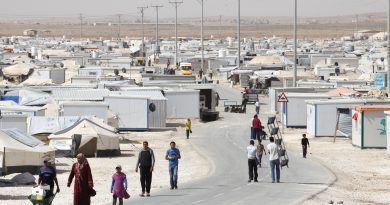The Ongoing Gang Wars in Central America
Joseph Brennnan
Staff Writer
Central America has gained notoriety for its exceptionally high levels of gang violence, particularly in countries like El Salvador, Honduras, and Guatemala. Gangs have evolved into formidable criminal organizations, exerting control over specific territories and engaging in a wide range of illicit activities, which pose significant threats to the region’s stability and security. The two most prominent and influential gangs operating in Central America are Mara Salvatrucha (MS-13) and Barrio 18 (Mara 18). Both gangs originated in the United States and later expanded their operations to Central American countries. These gangs are increasingly growing in size and power and are becoming major players in the region’s criminal landscape.
MS-13 has a reputation for extreme violence and has expanded its presence beyond Central America, reaching North America and even parts of Europe. Originally formed by Salvadoran immigrants in Los Angeles in the 1980s, MS-13 later established roots in El Salvador, Honduras, Guatemala, and other countries. MS-13 members are identifiable by their distinctive tattoos and hand signs. They engage in a wide range of criminal activities, including drug trafficking, extortion, human smuggling, and contract killings. Their operations often involve intricate networks that span national borders, making it difficult for law enforcement agencies to combat their influence effectively.
Barrio 18 is another significant gang operating in Central America. Much like MS-13, Barrio 18 was originally formed in Los Angeles before expanding operations to El Salvador, Honduras, and Guatemala, where it established a strong presence. Barrio 18 also engages in various criminal activities, including drug trafficking, extortion, robbery, and murder. The gang’s influence is characterized by a territorial structure, where different factions control specific neighborhoods or “barrios.” This territorial control creates a volatile environment as clashes between rival factions or attempts to expand territories often result in heightened violence and retaliatory acts.
The activities of these gangs have far-reaching consequences. Drug trafficking and the resulting drug trade, for example, fuel addiction, leading to devastating social and public health consequences. Extortion practices target businesses and individuals, hindering economic growth and creating an environment of fear and instability. Robberies and acts of violence committed by gang members further erode trust within communities and perpetuate cycles of violence. The influence of these gangs extends beyond their direct criminal activities. They often control informal economies within their territories, exerting control over local markets and exploiting vulnerable populations. Moreover, their presence disrupts social structures, leading to a breakdown in community cohesion and a loss of faith in public institutions.
Addressing the issue of gang violence in Central America requires a multi-faceted approach that encompasses law enforcement efforts, community engagement, and social development programs. The complex nature of these criminal organizations demands coordinated regional strategies, intelligence-sharing, and collaboration between law enforcement agencies across national borders. Addressing the root causes of gang involvement, such as poverty, lack of education, and limited economic and social opportunities, is crucial for breaking the cycle of violence and providing alternative pathways for at-risk youth. Central American governments, with the support of international organizations and partners, continue to work towards dismantling these gangs and mitigating their impact on society. However, it remains an ongoing challenge that necessitates long-term commitment and comprehensive solutions to ensure the safety and well-being of communities in Central America and beyond.
Understanding the root causes of gang violence in Central America is essential for formulating effective strategies to combat this issue. The region’s complex socio-economic and historical factors contribute to gang culture and recruitment, particularly among marginalized youth. Socioeconomic disparities play a significant role in the prevalence of gang violence. Central America faces significant income inequality, with a small portion of the population controlling a majority of the wealth, while many live in poverty. Specifically in El Salvador, World Food Programme reports that 40 percent of the population has lived in poverty since 2020. This disparity leads to a lack of resources and opportunities for disadvantaged communities, making them more susceptible to gang recruitment. Limited access to quality education, healthcare, and basic services further exacerbates these challenges, leaving young people with few avenues for upward mobility.
Inadequate educational opportunities contribute to the vulnerability of youth to gang recruitment. A deficient education system, marked by underfunding, overcrowded classrooms, and a lack of qualified teachers, hampers academic achievement and confines the potential of young students, often becoming suitable gang prospects. Without access to quality education, young individuals are more likely to turn to gangs as an alternative source of identity, protection, and economic opportunity. Healthcare deficiencies also contribute to gang violence. Limited access to healthcare services, including mental health support, can leave individuals feeling neglected and marginalized. Mental health issues, trauma, and unresolved conflicts within families and communities can drive young people toward gang membership as a means of finding belonging or as an outlet for their frustrations.
A scarcity of employment opportunities is another critical factor driving gang violence. High unemployment rates, particularly among youth, create a sense of hopelessness and frustration. The lack of legitimate job prospects pushes young individuals towards illicit activities as a means of survival or to gain financial stability. Family dysfunction and broken social structures also contribute to the vulnerability of youth to gang recruitment. Many families in Central America face challenges such as domestic violence, substance abuse, and parental neglect. These factors can lead to a breakdown in familial support and guidance, leaving young individuals susceptible to the influence of gangs that offer a sense of belonging and identity. Furthermore, the region’s history of civil wars and political instability has left lasting scars. These conflicts have displaced communities and eroded trust in public institutions. The aftermath of these wars often includes weak governance, corruption, and inadequate law enforcement, allowing gangs to flourish in environments marked by impunity and limited accountability.
Gangs in Central America establish their dominance through fear and coercion, often resorting to extortion as a means of control. Local businesses and residents are subjected to forced payments known as “war taxes” or “protection fees,” which drain resources from already struggling economies. This economic burden hinders development and discourages entrepreneurship, as business owners are hesitant to invest and expand in an environment plagued by violence and intimidation. The climate of fear perpetuated by gangs significantly impedes economic growth and stability. Entrepreneurs, fearing forced closure, may opt to shut down their businesses rather than endure the constant threats and extortion demands. The resulting loss of livelihoods and income opportunities further exacerbates poverty and social inequality within affected communities. In turn, the lack of economic growth and prosperity reinforces the conditions that fuel gang violence, perpetuating a vicious cycle.
Governments in Central America have acknowledged the urgent need to address this problem. One key approach is the strengthening of law enforcement operations. Governments have increased police presences and implemented targeted operations to dismantle gang structures and disrupt their criminal activities. These efforts often involve intelligence-led investigations, arrests, and prosecutions of gang members. By prioritizing public safety and cracking down on gang-related offenses, governments aim to create an environment that is less conducive to gang activities.
Regional collaboration is also crucial in addressing the transnational nature of gang activity. Initiatives such as the Central American Integrated System for the Prevention, Investigation, and Prosecution of Gang Crimes (CIS-GANG) promote information sharing and joint operations between countries. This collaboration strengthens the collective efforts of Central American nations in combating gang activities, enhancing intelligence sharing, and facilitating the extradition of gang members across borders.
Despite the concerted efforts made by governments in Central America to combat gang activity, however, reducing gang violence in the region continues to be a challenge. Gangs have demonstrated resilience and adaptability, often outmaneuvering law enforcement strategies and exploiting vulnerabilities within the justice system. Corruption within law enforcement agencies poses a significant obstacle to effective anti-gang measures. Some members of the police force, judiciary, or other government institutions may be complicit in or influenced by gang activities. This corruption undermines the trust and legitimacy of law enforcement efforts, allowing gangs to operate with relative impunity. It also hampers successful prosecutions, as corruption within legal systems can manifest in witness intimidation and evidence tampering.
While governments have demonstrated commitment to combating gang violence, numerous challenges persist. Gangs have proven to be adaptable and resilient, often evolving their tactics and strategies in response to law enforcement efforts. On top of corruption within law enforcement agencies, limited resources, including funding and training, impede the implementation of effective anti-gang measures.
Insufficient staffing, outdated equipment, and inadequate training for law enforcement agencies hinder their ability to tackle the complex and evolving nature of gang violence. Additionally, a lack of investment in intelligence gathering, technology, and information-sharing mechanisms can restrict the coordination and effectiveness of cross-border efforts to combat transnational gang networks. Overcrowded prisons throughout the region are filled beyond capacity and lack proper security measures, allowing gang members to strengthen their networks, recruit new members, and plan criminal activities within the confines of the prison walls. In some instances, prisons become de facto headquarters for gangs, further perpetuating their influence and power. Addressing prison overcrowding and implementing comprehensive rehabilitation and reintegration programs are essential in disrupting gang dynamics and preventing their continued expansion.
Addressing social factors involves investing in community development programs, promoting social cohesion, and providing support systems for at-risk youth. By focusing on education, vocational training, and mentorship programs, governments can provide alternatives to gang membership and equip individuals with the skills and opportunities necessary for a productive and lawful life. Economic strategies include job creation initiatives, promoting entrepreneurship, and facilitating access to financial services in underserved areas. By tackling the underlying economic inequalities and creating pathways to economic stability, governments can mitigate the allure of illicit activities and provide individuals with legitimate means of income and advancement.
Political reforms are also crucial in addressing the root causes of gang violence. Strengthening governance, enhancing transparency, and combating corruption are essential for creating an environment where the rule of law prevails. Effective and accountable institutions can restore public trust, ensuring that justice is served and providing a deterrent against gang activities. Addressing the root causes of gang violence requires collaboration between governments, civil society organizations, and international partners. Coordinated efforts and shared best practices can foster innovative approaches to prevention, intervention, and rehabilitation. Regional cooperation, information-sharing, and joint operations are instrumental in disrupting transnational gang networks and tackling the cross-border nature of gang activities.
Image courtesy of Wikimedia Commons




